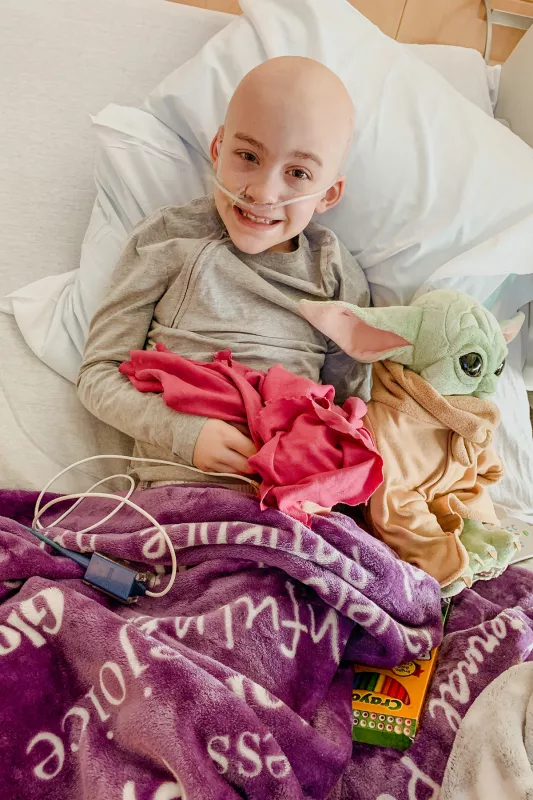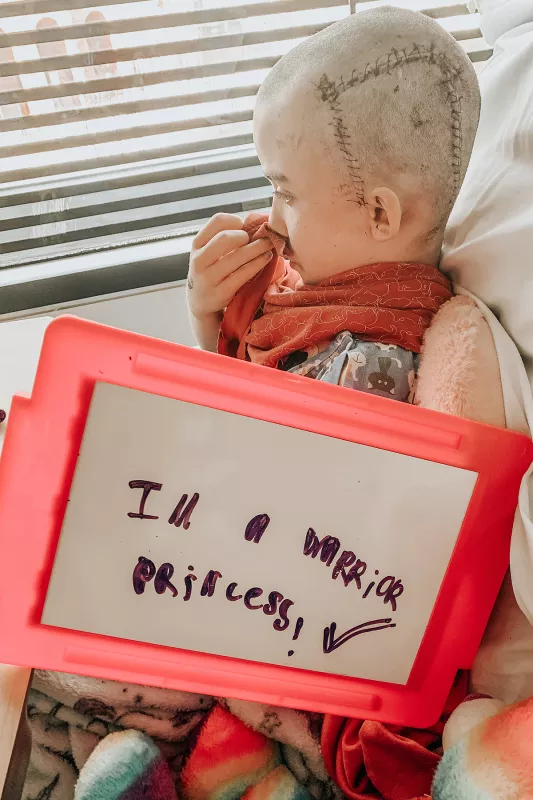Gracelyn Springer: The Girl Who Became 1% of the 1% — A Remarkable Fight Against Ewing Sarcoma

At eight years old, Gracelyn Springer was living a carefree, joyful life in a small Iowa town. She painted, sang, and danced her way through childhood, blissfully unaware that a silent threat was beginning to emerge within her body.
It began subtly — occasional headaches and bouts of nausea that seemed minor at first. But over weeks, the episodes worsened.
“It got to the point where it was almost every day,” recalls her mother, Kelsey. “She wasn’t just nauseous—she was vomiting.”
Then came the symptom that sent Kelsey’s heart into her throat: Gracelyn’s left eye began drifting toward the center, and she became sensitive to sounds at school. Something was seriously wrong.
For six to eight long weeks, Gracelyn’s parents sought answers. Blood work was normal. Routine exams revealed nothing. But Kelsey’s intuition told her that this wasn’t normal.
“This wasn’t normal,” she says.
A Race to Save a Child
On the morning of November 14, 2020, Gracelyn awoke again with a headache — followed by uncontrollable vomiting. Nothing could stop it.
“I had had enough,” Kelsey recalls. “There was something seriously wrong with our daughter.”
She rushed Gracelyn to the emergency room, where an urgent CT scan revealed the unthinkable:
“We found a mass in her brain.”
Within hours, Gracelyn was in an ambulance, racing toward University of Iowa Stead Family Children’s Hospital, the place that would become her lifeline for the next nine months.
A Surgery No Parent Is Ever Ready For
At Iowa City, specialists confirmed the mass with an MRI. The care team prepared for a craniotomy, a delicate surgery involving removal of part of the skull.
Due to COVID-19 visitor restrictions, only her father, Marty, could accompany her — a small mercy, but one that mattered deeply.
“That compassion meant everything to us,” Kelsey says. “She needed her daddy, and her daddy needed her.”
Before surgery, the team explained that half of Gracelyn’s hair would need to be shaved. For a young girl, this was more than a medical procedure; it was an emotional ordeal.
“Her hair was her favorite part of herself,” Kelsey recalls. “It was long and beautiful. But she didn’t want it half gone. So we shaved it all. It was excruciating, but it had to be done.”
During surgery, doctors discovered that the tumor had grown from her mastoid bone, behind the ear, pressing inward toward her brain. The operation lasted eight to ten hours, and the risks were severe: potential loss of speech, vision, or neurological function.
When Gracelyn awoke, however, she emerged unscathed, a miraculous outcome her parents could hardly believe.
“They removed the entire tumor. She came away with no deficits. It was a blessing we never expected,” Kelsey says.

A Diagnosis Rarer Than Rare
The biopsy confirmed what no one had imagined: Ewing sarcoma, a highly aggressive cancer.
Most Ewing tumors form in long bones or soft tissue. Only 1% occur in children’s skulls.
“Gracelyn is 1% of the 1%,” Kelsey explains. “It made the fear so real. So much more plausible.”
This meant she would require the most aggressive treatment available, including intensive chemotherapy and radiation.
Nine Months in the Hospital
For 14 rounds of chemotherapy, Gracelyn was admitted every other week. On her off-weeks, the treatments’ side effects left her nearly as sick.
“The hospital became our home away from home,” Kelsey says. “We were there every week.”
Additionally, she underwent 30 rounds of radiation at a specialized facility. While lifesaving, the treatments came with lasting consequences:
-
Damage to her pituitary gland, requiring daily hormone injections
-
Permanent hair loss on the left side of her head
-
Hearing loss
-
Cardiomyopathy, a condition affecting heart function
Through it all, Gracelyn fought with unwavering courage.

A Medical Team That Never Gave Up
Even as her case stretched medical expertise, her family’s confidence in her care team never wavered.
“Her doctors have never treated someone like her,” Kelsey says. “That might shake another parent’s confidence. But not ours. They listen. They respect us. They fight for her. They research. They try to improve. We worry about so much as parents of a child with cancer—but her medical team is not one of them.”
The collaboration, diligence, and empathy of Gracelyn’s doctors, nurses, and specialists were critical in giving her a chance at life.
Life Moving Forward
Now 10 years old and in fifth grade, Gracelyn is thriving. She paints, crafts, sings, and dances, embracing creativity as a source of light and joy.
Her cancer is officially in remission, and she continues regular visits to monitor her health. Despite the challenges of treatment, she radiates optimism and resilience.
“A cancer diagnosis for your child is life-shattering,” Kelsey says. “But we truly appreciate every member of her team. Each one played a role in saving her life. We would trust no one else with our daughter’s future.”
Gracelyn, 1% of 1%, is making the most of every day.

Lessons From Gracelyn’s Story
Gracelyn Springer’s journey teaches us about:
-
Parental intuition: Kelsey’s persistence and instinct may have been the first step that saved Gracelyn’s life.
-
Specialized pediatric care: Access to a highly skilled team at Stead Family Children’s Hospital ensured early intervention and expert treatment.
-
Resilience and courage: Even in the face of rare cancer, devastating side effects, and long hospital stays, Gracelyn fought every day.
-
The power of hope: Small victories — a hair cut, a pain-free moment, a smile — mattered just as much as medical breakthroughs.
Gracelyn’s story reminds families and caregivers everywhere that even the rarest, most daunting challenges can be met with determination, love, and expert care.











